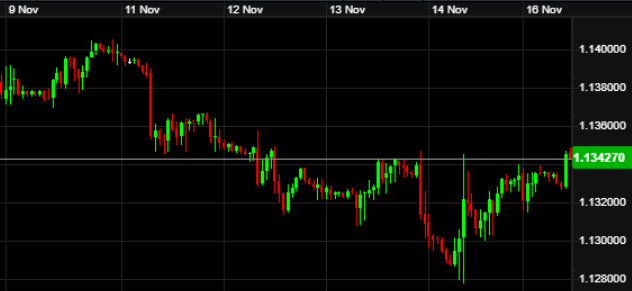ACM Update 17-11-25

Sterling continued its recent difficult run week last week, hitting a fresh 31-month low against the Euro in the process. Unemployment rose and growth remained stagnant, whilst further Government U-turns created more uncertainty in GBP.
In the US, the longest running Federal shutdown in history came to an end, until January at least.
This week sees the publication of the latest UK inflation data on Wednesday. There is also likely to be a flurry of US data releases, those which were not published during the shutdown. Expect plenty of Dollar volatility as a result.
Disappointing to poor economic data, mixed with a distinct lack of confidence in Downing Street, caused further problems for the pound last week. This saw the currency hitting a fresh low dating back to April 2023 against the Euro at one point on Friday morning.
The bad news in the UK started off with Tuesday morning’s September unemployment data. This demonstrated further weakening in the jobs sector as headline unemployment hit 5.0% in the process, above estimates. The last time the metric started with a five was in early 2021, emerging from COVID lockdowns.
In the simultaneous releases, average earnings cooled slightly to 4.8%, still running well ahead of inflation. The number of those claiming benefits also rose by more than hoped.
Whilst the jobs market struggles, GDP figures are also facing pressure. The UK economy actually shrank by -0.1% in September, leaving Q3 overall with a dizzy 0.1% of expansion. This continues the downward trajectory seen thus far in 2025, following growth of 0.7% and 0.3% in the first two quarters. The ONS (Office for National Statistics) figures showed UK car production lagging considerably, with blame placed on the Jaguar Land Rover cyber-attack halting work.
Not only are the unemployment and growth figures generally bad news, but they are both leaning the Bank of England closer to a rate cut in their December meeting. A slowing jobs market and an economy seemingly strangled by higher interest rates, are likely to force the hand of the BoE. A drop in headline inflation in this Wednesday’s publication would seemingly make a December rate cut highly likely. All of this is GBP-negative.
A further factor in last week’s GBP weakness came from a Wednesday Financial Times article. This suggested that Sir Keir Starmer and Rachel Reeves had shelved their previously (not very subtly) hinted plans to put up income tax in the 26th of November Budget. This was confirmed by Reeves later in the day, citing “better than expected economic forecasts” had led to her budget deficit being £10bn less than previously thought.
The above reversal saw Government borrowing costs yo-yoing throughout the week, but the effect on the currency overall was again negative. GBP is on a bit of a lose-lose at present. The prospect of tax hikes previously weakened the pound due to growth concerns, whilst not cutting them spiked deficit concerns, weakening also. What will happen in the Budget, tune in next Wednesday to find out!
We also heard from a few Bank of England policymakers last week. Governor Bailey reaffirmed that the “major shift” in the US makes things uncertain, but the “underlying path is down” on interest rates. Chief Economist, Huw Pill, warned that ongoing rate cuts “might not be rapid”. Whilst Megan Greene, who was also confirmed for a second term last week, doesn’t feel current monetary policy is restrictive enough. Needless to say, all three voted for rates to be held in the recent meeting.
Concerns about looming rate cuts weigh heavily on GBP still, not to mention the will she/wont she, that is the Reeves Budget. Movements on GBP-EUR last week can be seen in the chart below:

The Euro made gains against both the pound and US Dollar last week, primarily due to bad news elsewhere. We have already covered the GBP side of the equation above, whilst Eurozone news was relatively thin either side of Tuesday’s bank holiday in some nations.
Flash GDP for the bloc came in as 0.2% growth in Q3. This was in line with forecasts and also beats the 0.1% seen in Q2. It does however fall short of the same quarter in 2024, which produced 0.4%. The next nation to join the single currency in January, Bulgaria, was one of the strongest performers. Overall employment for the continent was up 0.1% in Q3 also.
ECOFIN meetings also took place in Brussels last week. One hot topic was regarding the problem of low value parcels flooding European postal services, from Chinese discount companies such as Shein and Temu. The last gathering of EU Finance Ministers saw an agreement on adding customs duties to these, the implementation of which is now to be accelerated.
US news was largely dominated by the agreement reached to end the longest-running Federal shutdown in history. Congress, the House of Representatives and the Senate all narrowly agreed to the proposals, before Donald Trump used his favourite big marker pen to sign the spending bill in the Oval Office.
This only kicks the can down the road for now though, and only until the 30th January at that. Come then, we can look forward to further discussions on the matter to be dominating headlines once more.
Donald Trump was busy in other headlines last week too. The President’s run-in with the BBC saw heads roll, amidst a potential lawsuit about dodgy editing of a speech. The President also signed another executive order reversing tariffs on many food products. Trump claimed it was because the specific products can’t be produced domestically in enough quantity.
The tariff cuts come as the White House faces continued pressure over price rises. In theory these cuts should help food price inflation. Either that or Donald is seemingly a big fan of beef, coffee, bananas, avocados, tomatoes, coconuts and oranges (amongst others).
We also got to hear from an assortment of Federal Reserve policymakers last week, on their interest rate thoughts. Despite just a few weeks ago markets feeling that a December rate cut was nailed on, committee members weren’t as confident. Some went as far as warning that a December cut could be a damaging move.
The panel seem to be split on whether the current economic slowdown in the US will intensify. Jeffrey Schmid of the Kansas City Fed, feels cutting interest rates too soon could have longer lasting effects on their 2% inflation objective, ruining years of work in the area. For more clues, the minutes from the last Federal Reserve meeting are published this Wednesday evening.
Movements on GBP-USD last week can be seen in the chart below:

The week ahead:
Monday – BoE Mann speech (13:20), Federal budget balance (19:00), Fed Waller speech (20:35)
Tuesday – BoE Pill speech (13:00), US Factory Orders (15:00), BoE Dhingra speech (17:00)
Wednesday – UK CPI inflation (07:00), EU Final CPI (10:00), Federal Reserve meeting minutes (19:00)
Thursday – US Non-Farm Payrolls (13:30), EU Consumer Confidence (15:00)
Friday – UK Retail Sales (07:00), EU/UK/US Manufacturing & Services PMIs (08:15-14:45), ECB Nagel speech (13:00), BoE Pill speech (15:40)
With the US shutdown now over, we can expect a real flurry of data releases this week. The heavily delayed September Non-Farm Payrolls report is due to be published on Thursday. Market estimates are likely to be incredibly varied for this, so the potential for market movement is high off the back of it.
Also from the US, the minutes from the end of October’s Federal Reserve meeting will be published on Wednesday evening. These are likely to give more detail on the divide mentioned above, between two sets of policymakers.
UK news is busier this week too with CPI inflation figures for October to come on Wednesday, first thing. These are projected to show a drop to 3.6%, which would be the first move back down from the recent 3.8% plateau seen since July. This data will be key in assisting the Bank of England committee as to what to do with interest rates next month.
Also from the UK we have retail sales data on Friday for October. There are also a range of speeches throughout the week from Bank of England policymakers. These will contain a firm split of opinions, from the likes of Catherine Mann, Swati Dhingra & Huw Pill.
In Europe, their own Final CPI figures for October are expected to show a slight nudge up to 2.2% in the month. We will also have Consumer Confidence data, as well as the range of PMI readings from the respective nations, in the Manufacturing and Services sectors. There are also G20 meetings taking place over the weekend in Johannesburg.
Given the amount of backdated US data to be published over the next few weeks, we can expect plenty of Dollar-related market movement to come. The UK side will also be heavily influenced by pre-Budget information. As we saw last week, this can create plenty of volatility.
For any upcoming foreign exchange requirements, make sure to reach out to the Aston team to discuss in more detail.
Have a great week.